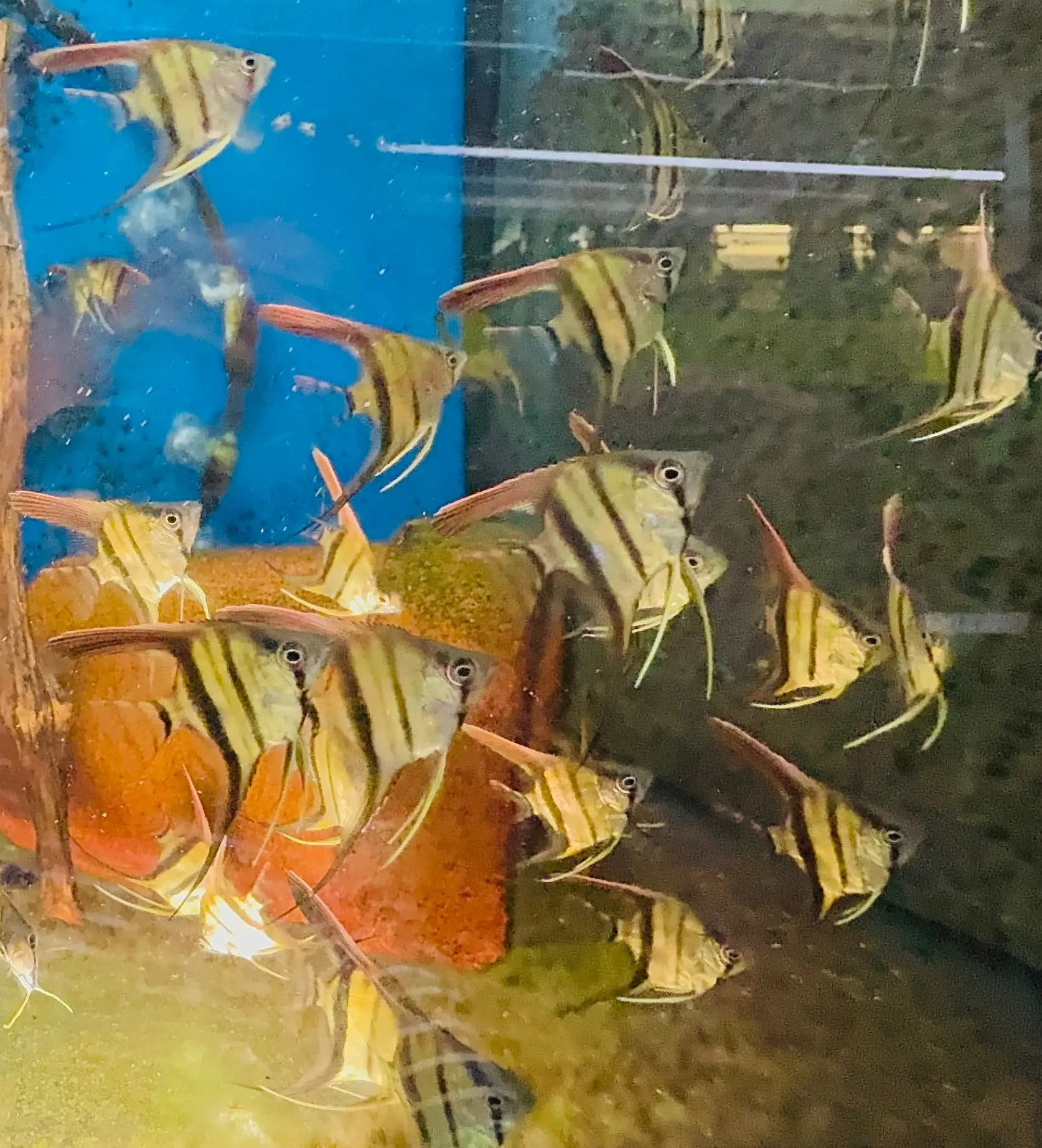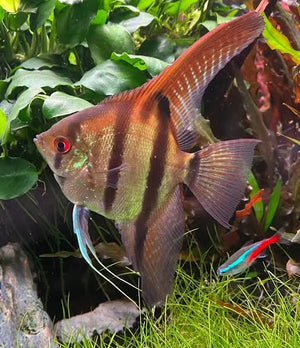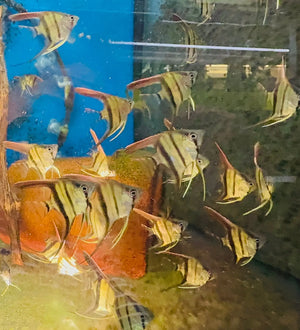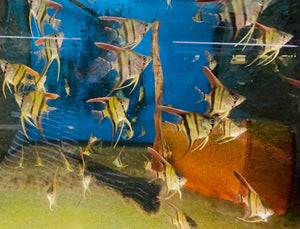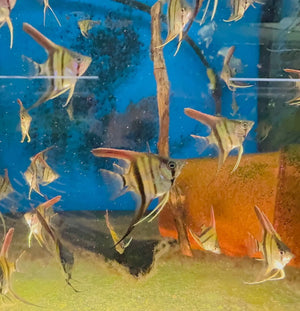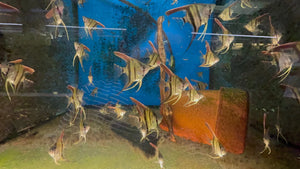Angel Fish - Amanpa Redback 4cm
Order today - receive it in as little as 3-5 days.
Return within 30 days of purchase. Duties & taxes are non-refundable.
Guarantee Safe Checkout
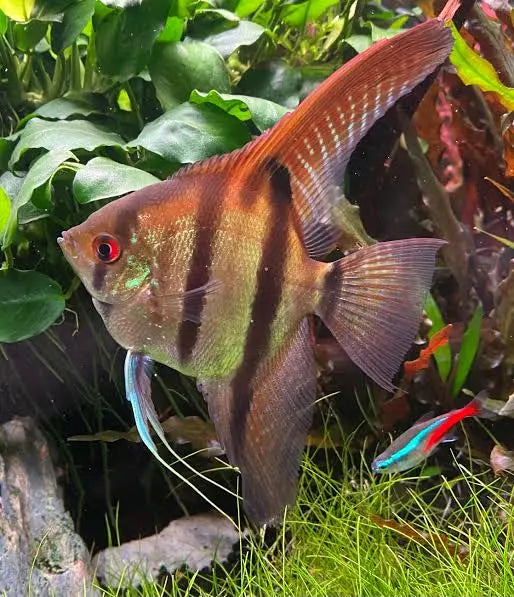
Angel Fish - Amanpa Redback 4cm
RedBack Amapa Angelfish (Pterophyllum scalare) - Unique Aquarium Fish
In the world of freshwater aquarium fish, the RedBack Amapa Angelfish is a standout. It's known as Pterophyllum scalare. We're excited to share its unique qualities and why it's loved by many. This fish, with its striking looks and graceful moves, has won the hearts of many in Australia. It's a freshwater fish from the Amazon basin. It's famous for its bright colours, majestic fins, and fascinating behaviour. It's a real showstopper in any aquarium.
This fish, with its striking looks and graceful moves, has won the hearts of many in Australia. It's a freshwater fish from the Amazon basin. It's famous for its bright colours, majestic fins, and fascinating behaviour. It's a real showstopper in any aquarium.
Key Takeaways
-
The RedBack Amapa Angelfish is a stunning freshwater fish species that has become a popular choice for aquarium enthusiasts.
-
It is known for its vibrant colours, elegant fins, and captivating behaviour, making it a true focal point in any home aquarium.
-
As a native of the Amazon basin, the RedBack Amapa Angelfish offers a glimpse into the rich diversity of the region's aquatic life.
-
With its unique characteristics and care requirements, this species is a rewarding addition for experienced fish keepers looking to add a touch of elegance to their aquatic environments.
-
Exploring the RedBack Amapa Angelfish's natural history, physical features, and optimal care needs can help aquarium enthusiasts provide the best possible environment for this remarkable fish.
Introduction to the Majestic RedBack Amapa Angelfish
We're excited to share with you the RedBack Amapa Angelfish. It's a standout among cichlid species from the Amazon. Known as Pterophyllum scalare, it's loved for its beauty and interesting history.
Natural Habitat and Distribution
The RedBack Amapa Angelfish lives in the Amazonian biodiversity of South America. They thrive in the Amazon's slow rivers and tributaries. Their home includes Brazil, Peru, and Colombia, where they live with many other tropical fish keeping species.
Historical Background
The RedBack Amapa Angelfish has a long history. It was first found by European naturalists in the 19th century. Since then, it's become a favorite in aquariums around the world.
Conservation Status
The RedBack Amapa Angelfish is still popular in tropical fish keeping. But, it faces big challenges. Habitat loss and pollution in the Amazon threaten their survival. It's vital to support conservation and practice responsible tropical fish keeping to protect them.
Physical Characteristics and Appearance
The RedBack Amapa Angelfish is famous for its bright and striking colours. It's a top pick in the fish trade. This fish has a deep red colour that covers its wide body. Its fins are long and elegant, adding to its beauty.
This fish stands out because of its body shape. It has a deep, round body and a tall dorsal fin. Its fins, especially the long pectoral and pelvic fins, make it look graceful and stunning.
|
Physical Characteristic |
Description |
|
Body Coloration |
Vibrant red hues across the body, with contrasting accents of silver and black |
|
Body Shape |
Deep, laterally compressed profile with a tall, triangular dorsal fin |
|
Fin Structure |
Long, flowing pectoral and pelvic fins, creating a stunning, elegant appearance |
The RedBack Amapa Angelfish is a real showstopper in the ornamental fish trade. Its vibrant colors and unique look have won it many fans. Aquarium lovers can't get enough of its beauty and elegance.
Angelfish, RedBack Amapa, Pterophyllum scalare: Species Overview
We're excited to dive into the world of the RedBack Amapa Angelfish, or Pterophyllum scalare. This freshwater fish is a standout for anyone who loves aquatic pets and vibrant tanks.
Distinctive Features
The RedBack Amapa Angelfish stands out with its unique look. It has a tall body and flowing fins, making it look like an angel. Its back is a deep red, and its fins and body have cool patterns.
Size and Growth Patterns
Adult RedBack Amapa Angelfish can grow up to 15 centimetres (6 inches). Their size depends on tank size, water quality, and diet. With the right care, they can reach their full size.
Gender Differences
-
Females have a rounder body than males.
-
Males show brighter colours and bigger fins.
-
Sexually mature females have swollen abdomens during spawning.
Knowing about the RedBack Amapa Angelfish's features, growth, and gender differences is key. It helps in caring for them and keeping a healthy aquarium.
Optimal Tank Setup and Water Parameters
Keeping RedBack Amapa Angelfish in your aquarium needs careful attention to their tank and water. As tropical fish keeping fans, we know the right environment is key for their health. It's important for their well-being. The tank size is crucial. RedBack Amapa Angelfish are big and need lots of room to swim. A tank of at least 45 gallons (170 litres) is recommended for one adult. For a group, the tank size should be even bigger. The tank should be tall to match their natural habitat.
The tank size is crucial. RedBack Amapa Angelfish are big and need lots of room to swim. A tank of at least 45 gallons (170 litres) is recommended for one adult. For a group, the tank size should be even bigger. The tank should be tall to match their natural habitat.
-
Ideal tank size: Minimum 45 gallons (170 litres)
-
Tank should be taller than wide
-
Increase tank size for a group or community setup
The water conditions are also very important. These fish do best in slightly acidic to neutral water, with a pH of 6.5 to 7.5. The water temperature should be between 24-28°C (75-82°F). This matches their natural habitat in South America's tropical regions.
|
Parameter |
Ideal Range |
|
pH |
6.5 - 7.5 |
|
Water Temperature |
24-28°C (75-82°F) |
Choosing tank mates is also important. RedBack Amapa Angelfish are generally peaceful. They can live with other calm, non-aggressive aquatic pet care species. But, avoid big, aggressive fish that might bully them.
By carefully setting up the tank and keeping the water right, you'll make a great home for your RedBack Amapa Angelfish. They'll thrive in your aquarium.
Diet and Feeding Requirements
Keeping our RedBack Amapa Angelfish healthy is key. Their diet is vital for their well-being. We'll explore their natural diet, recommended foods, and feeding times.
Natural Diet Preferences
In the wild, RedBack Amapa Angelfish eat plants and small animals. Their diet includes:
-
Algae and aquatic plants
-
Small crustaceans, such as brine shrimp and daphnia
-
Microscopic organisms, like zooplankton
Recommended Food Types
For a balanced diet, we recommend these foods for our captive RedBack Amapa Angelfish:
-
High-quality flakes or pellets for tropical fish
-
Live or frozen foods, like brine shrimp and daphnia
-
Freeze-dried or rehydrated freeze-dried foods, including tubifex worms and krill.
-
Occasional boiled or blanched vegetables, like spinach and zucchini
Feeding Schedule
Feeding them regularly is important. Feed them small amounts two to three times a day. Make sure they eat everything in a few minutes. Don't overfeed to avoid water quality issues.
|
Feeding Frequency |
Food Types |
Portion Size |
|
2-3 times per day |
Flakes, pellets, live/frozen foods |
An amount the fish can consume within 2-3 minutes |
Following these dietary guidelines helps our RedBack Amapa Angelfish thrive. They will continue to amaze us in our aquariums.
Breeding and Reproduction Guidelines
The RedBack Amapa Angelfish (Pterophyllum scalare) is truly captivating. Breeding them can be delicate but rewarding. Here are some guidelines to help you successfully breed these stunning fish in your aquarium.
The courtship ritual of the RedBack Amapa Angelfish is amazing. Males perform intricate dances, showing off their vibrant colours. They clean a surface for the female to lay her eggs.
-
The eggs, usually hundreds, hatch in 2-3 days, depending on the water temperature.
-
After hatching, the fry eat the yolk sac first. Then, they need brine shrimp or crushed flakes within a week.
-
Keeping the water conditions right is key. This includes pH, temperature, and oxygen levels for the fry's growth.
A big challenge is the parents eating their fry. To avoid this, remove the eggs or separate the parents from the fry after hatching.
|
Breeding Parameter |
Optimal Range |
|
Temperature |
82-86°F (28-30°C) |
|
pH |
6.8-7.5 |
|
Water Hardness |
5-15 dGH |
By understanding RedBack Amapa Angelfish breeding, you can raise healthy, vibrant offspring. Seeing these majestic fish grow from egg to adult is incredibly rewarding for any angelfish lover.
Conclusion
The RedBack Amapa Angelfish is a standout freshwater aquarium fish. It's a unique cichlid species from the Amazon basin. This shows the amazing biodiversity of the region and the need for responsible fishkeeping. By setting up the right tank and caring for these fish, we can make them happy in our homes. Adding RedBack Amapa Angelfish to our aquariums is not just about their beauty. It also helps protect Amazonian ecosystems.
By setting up the right tank and caring for these fish, we can make them happy in our homes. Adding RedBack Amapa Angelfish to our aquariums is not just about their beauty. It also helps protect Amazonian ecosystems.
In short, the RedBack Amapa Angelfish is a treasure for aquarium lovers. We should all think about adding this special cichlid to our tanks. This way, we can enjoy their beauty and help save the Amazon's incredible biodiversity.
FAQ
What is the RedBack Amapa Angelfish?
The RedBack Amapa Angelfish, also known as the Pterophyllum scalare, is a unique freshwater cichlid. It's native to the Amazon basin. It's loved for its vibrant look and engaging personality.
Where do RedBack Amapa Angelfish come from?
They come from the Amazon River and its tributaries. Mainly from Brazil, Peru, and Colombia. They love the warm, slow waters of the Amazon, known for its rich life.
What makes the RedBack Amapa Angelfish special?
They have a stunning red back that contrasts with their silvery-grey body. Their unique shape and fins make them a standout in any aquarium.
How big do RedBack Amapa Angelfish grow?
They can grow up to 15 centimetres (6 inches) long. But usually, they reach about 12 centimetres (4-5 inches). Their size depends on water quality, tank size, and diet.
How do I tell the difference between male and female RedBack Amapa Angelfish?
Telling males from females is tricky. Males are usually bigger with longer fins. Females are rounder and less colourful.
What kind of tank setup do RedBack Amapa Angelfish require?
They need a well-planted, dimly lit tank with gentle water. A tank of at least 125 litres (30 gallons) is best. Keeping the water right, with neutral pH and warm temperatures, is key to their health.
What should I feed my RedBack Amapa Angelfish?
In the wild, they eat small invertebrates, algae, and plants. In tanks, feed them high-quality flakes, pellets, and occasional live foods. A varied diet is important, and don't overfeed.
How do I breed RedBack Amapa Angelfish?
Breeding them is rewarding but challenging. They need specific water conditions to spawn. A dedicated breeding tank, right water, and careful monitoring are essential for success.
| Quantity |
1 fish |
|---|

